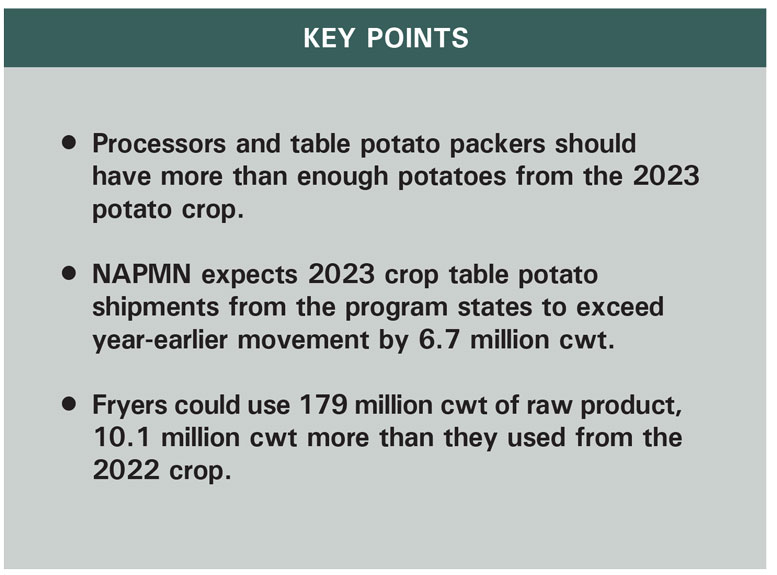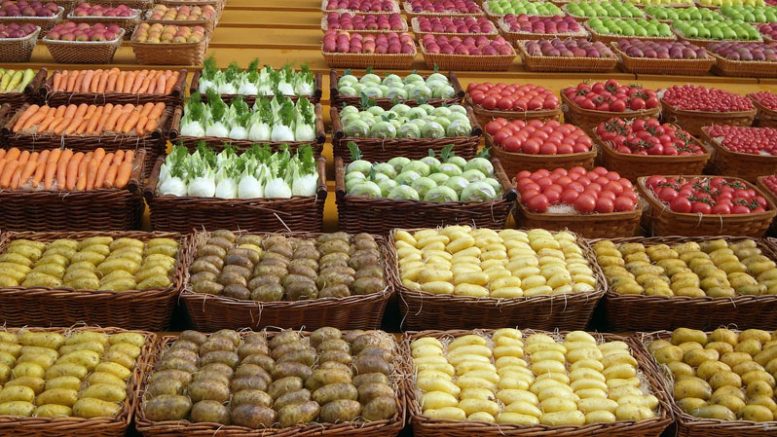|
Click to listen to this article
|
By Ben Eborn, Publisher, North American Potato Market News

At 431.8 million cwt, U.S. potato production, in the reporting states, is expected to exceed the 2022 crop by 33.1 million cwt. (That is according to North American Potato Market News’ (NAPMN) estimate as of press time). A large portion of the 8.3 percent increase was intended for the frozen processing industry, but the expansion has already impacted the table potato and dehydrated product sectors.
Table 1 outlines our current usage projections for the 2023 crop, along with a three-year history of usage, as reported by USDA. Please note that relative demand between the industry sectors and market forces could alter the distribution of the 2023 potato crop, relative to our current outlook. In this article, we lay out our projections for the various industry sectors in greater detail.
Table Potatoes
Program states shipped 80.3 million cwt of table potatoes from the 2022 crop. That is 437,000 cwt less than they shipped a year earlier. Current shipments are on course to exceed 2022-crop movement. We believe that supply conditions and market forces will allow for a 6.7 million cwt increase in crop-year shipments, to 87 million cwt, an 8.3 percent increase.
In addition, the product mix could be different. Early-season red potato shipments are down 1.3 percent. Growers in most regions continue to shift acreage from red to yellow potatoes. Red potato shipments from the storage states could be relatively flat this year. Yellow potato shipments are running 15.6 percent ahead of last year’s pace and are likely to exceed the 2022-23 pace throughout the storage season. The russet potato supply situation is complicated by its intersection with the processing industry. In contrast to the past two years, russet potato supplies are plentiful, given Idaho’s 35,000-acre planted area expansion and strong yields. Early russet shipments have been running 1.8 percent ahead of the 2022 pace. However, shipments are starting to pick up. Packers shipped 1.36 million cwt of russet table potatoes during the week ending Sept. 23. That is 157,000 cwt more than year-earlier shipments, a 13 percent increase. Russet movement will likely remain strong throughout the storage season. Our table potato shipping forecast depends on retailers’ willingness to reduce prices and move substantially more volume than they have during the past two years.
Frozen Processing
NAPMN expects fryers to use 179 million cwt of potatoes from the 2023 crop. That is 10.1 million cwt more than last year’s reported usage, a 6 percent increase. It exceeds 2021 usage by 8.25 million cwt, or 4.8 percent. The increase is due to strong domestic and export demand for French fries and other frozen products. North American fryers shipped 2.1 percent less frozen potato products to offshore markets during the year ending June 30 than they did a year earlier. Global French fry exports grew by an average of 4.8 percent during the past 10 years.
Raw-product supplies should be plentiful this year, especially in the Pacific Northwest. North American fryers may be able to re-capture some of their lost market share during the 2023-24 processing season. Fryers have expanded their processing capacity during the past several years. However, market constraints and labor challenges may hold processing use for the 2023 potato crop below our estimate.
Dehydration
We expect dehydrators in the eight reporting states to use 45 million cwt of potatoes from the 2023 crop. That is 7.3 million cwt more than they used from the 2022 crop, a 19.5 percent increase. It exceeds 2020-crop usage by 1.27 million cwt, or 2.9 percent. Demand for dehydrated products appears to be strong. U.S. potato flake exports during the April-June quarter jumped 66.8 percent above year-earlier sales to 51.56 million pounds. Most of the U.S. dehy processing capacity is in Idaho. Raw-product supplies should be plentiful to keep dehydrators running at capacity.
Other Eight States Processing Use
This is the difference between total processing use reported for the eight states and usage reported for dehydration and frozen products. It may include usage at chip plants in the reporting states, as well as other miscellaneous uses. At 13 million cwt, use in this category would fall 1.3 percent. Usage has been relatively stable at 12-13 million cwt each year.
Other Processing Use
This is the difference between total processing use reported for the program states and usage reported for the eight processing states. This is where most of the program states’ chip potato usage would show up. At 45 million cwt, we are projecting a 7.3 million cwt increase in 2023-crop processing use outside of the eight reporting states. Despite the 5.3 percent increase, projected usage in this category falls below 2020 and 2021 levels. Chip potato use could exceed our estimate if storage supplies are sufficient to offset the need for early new-crop potatoes.
Seed Potatoes
Excess supplies of table and processing potatoes will reduce prices. That should encourage acreage reductions in 2024. At 18 million cwt, NAPMN expects seed movement from the program states to decline by 1.7 percent relative to the 2022 crop.

